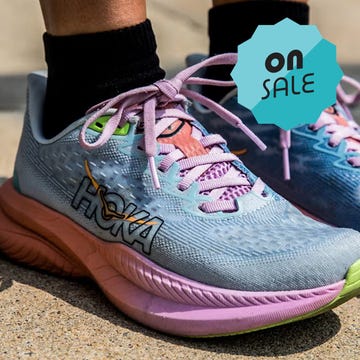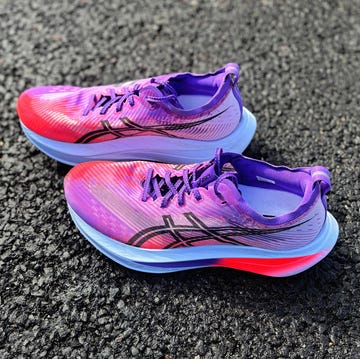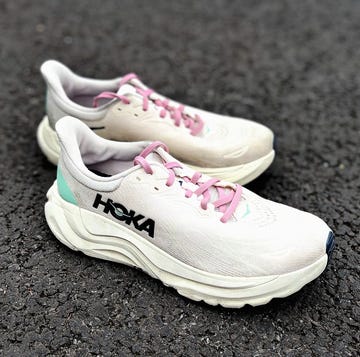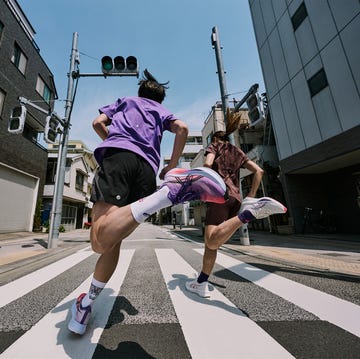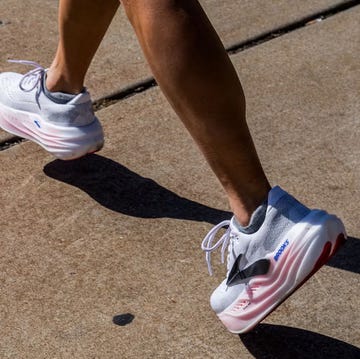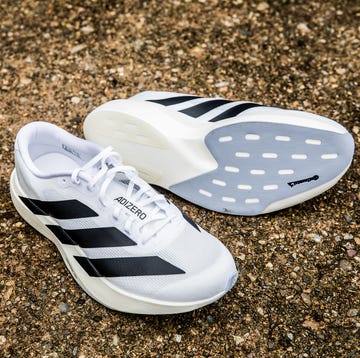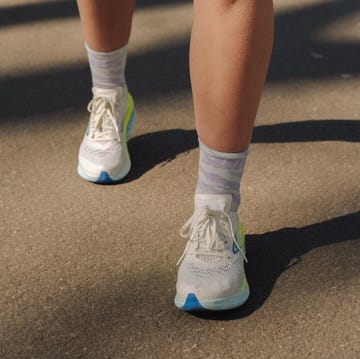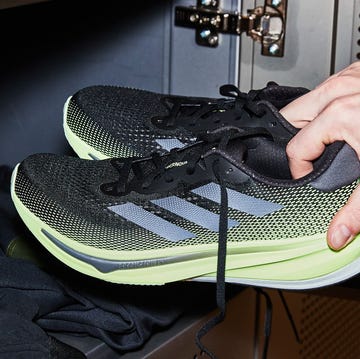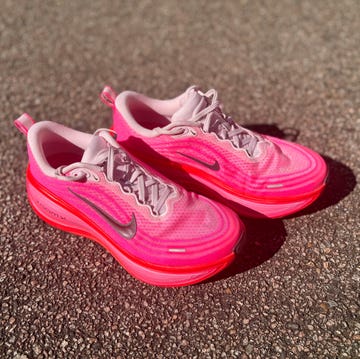- Weight: 302g (UK 8.5)
- Stack height: 38mm (heel), 28mm (forefoot)
- Drop: 10mm
- Tester details:
- Ali: 175cm/67kg/neutral gait/heel striker
- Rachel: 161cm/50kg/neutral gait/midfoot striker
The shoe
It has been two years since Puma released the original ForeverRun Nitro – a shoe that emerged as a modern, cushioned yet lightweight stability offering that worked just as well for neutral runners in need of extra support as it did for overpronators. The latest iteration seeks to be a continuation of that, upping the stability tech and introducing a new ‘co-moulded’ midsole (more on this below), upper and heel collar to increase overall comfort. But does it live up to its predecessor and how does it compare with the best overpronation running shoes? We’ve been logging the miles in it to find out. (Just to preface: neither of us pronate when we run, but we have tested a number of stability shoes and always welcome some extra support, especially since we run five or six times a week.)
How does the ForeverRun Nitro 2 fit?
Ali: I’ve often found Puma shoes to run quite narrow, but the ForeverRun Nitro 2 feels plenty roomy in my standard UK 8.5, presumably due to that wider midsole. That said, the toe box does taper quite dramatically around the toes and it also has a lower volume overall. I’ve not experienced any irritation in this area, but it’s worth bearing in mind if you’re someone with higher volume feet.
Puma has increased the stability tech in this second iteration, but, like many modern-day stability shoes, this comes from the shoe’s design rather than traditional medial posts. Dubbed RUNGUIDE technology, the system includes PWRTAPE overlays on the lateral and medial sides, a new TPU heel clip, an updated heel counter geometry and an orthotic insole – all aimed at keeping the foot aligned and centred through your stride.
What everyone's reading
The biggest change to the shoe, as I’ve mentioned, is the wider midsole, which flares in specific areas to provide greater control. This does add some weight to the shoe, with my UK 8.5 weighing in at 303g. For a daily trainer, that’s definitely on the hefty side.
Up top, a new engineered knit upper and rolled heel collar offer improved comfort over the first iteration, although I wouldn’t that say breathability has noticeably improved. The heel lockdown is great, though.
There’s a surprising amount of give in the forefoot’s upper, but the midfoot hold – where you need it – is solid. That said, I did need to adjust the lacing system quite a bit to achieve this. The tongue is also very thin and minimally padded – not necessarily a drawback, but it does mean that you need to be careful not to tie up the laces too tightly, as this creates pressure on the top of your foot. On that note, the laces are quite short, which could be an issue if you prefer a lace-lock system.
Another key feature of the shoe is the slightly higher side walls, designed to sit you within the shoe for added control. This is nothing new – it’s a core element of many stability shoes and Hoka’s entire road line-up – but in the ForeverRun Nitro 2, I found it to be a bit too much. The walls feel particularly high and stiff and, on my right foot, they’ve been rubbing against the lateral side on pretty much every run.
Overall, then, it’s a bit of a hit and miss fit for the ForeverRun Nitro 2. While the toe box and midfoot hold are well-executed, minus perhaps that low volume, the rear of the shoe feels overbuilt – too high and too rigid, particularly for a neutral heel striker like me. For the v3, I’d love to see Puma scale things back slightly, striking a balance between the first and second iterations.
Rachel: To echo Ali, the ForeverRun Nitro 2 is a noticeably chunkier shoe that other Puma offerings, coming in wider and heavier than the Velocity Nitro 3 – which offers a cushioned, comforting ride for everyday runs – and the peppier Deviate Nitro 3, which is an absolute staple in my own running rotation.
In fact, before you’ve even stepped foot in this shoe, you can just see that there’s a lot going on. The mesh upper looks like a thick knit, while the all the components that form the heavy-duty RUNGUIDE technology – especially the pronounced TPU heel clip – add to the sense of bulk.
Even the process of putting on the shoe made me continue with the belief that this shoe is overengineered. Unlike most daily trainers, which are easy to slip on and secure, the ForeverRun Nitro 2 is quite a tricky shoe to get into. The collar is a busy elasticated extension of the upper, which then feeds into a big wedge of cushioning around the heel, resulting in quite a restricted opening. I have narrow feet and still found it be quite a squeeze.
That said, and perhaps thanks to my slimmer foot, the tongue locks down my foot nicely, creating a fit that’s just right. This is assisted by a toe box which, unlike Ali, is roomy enough for my smaller, more compact toes, with the shoe itself (I wear a women’s UK size 6) fitting true to size.
There’s nothing worse than having a tongue so thin and narrow that it folds over itself under the lace system (I’m looking at some of the weight-shaving super shoes out there) and shrivels up into a bit of fabric that causes more discomfort than benefit. So, with the ForeverRun Nitro 2, it’s nice to have a slightly thinner tongue that is still comfortable – for me, at least – and doesn’t distort out of place. My only minor complaint in this area relates to the relatively thin laces, as I’ve found it quite hard to secure them neatly and compactly over the tongue. At times, it feels a tad cutting against the hands when I try to tighten them.
Once firmly laced into the shoe, it does still feel a little on the substantial side – if not a little static. But is this a bad thing? Not in my opinion. This stability shoe very much ticks the ‘stability’ box and noticeably counters any inward (or indeed outward) rolling of the foot – and that was the brief, was it not?
What’s it like to run in the ForeverRun Nitro 2?
Ali: Like the original, the shoe has a dual-density midsole, using two different versions of Puma’s Nitro foam: a firmer outer layer and a softer inner core – the idea being that you get a balance of cushioning and responsiveness. While previously the two were glued together, this time around it’s co-moulded. In theory, this should add some flexibility and durability to the shoe.
Now I’m someone who likes my cushioning to sit on the firmer side of softness (case in point, the On Cloudsurfer 2, which is a shoe that I’ve been enjoying recently), so I like the underfoot sensation of the ForeverRun Nitro 2. It’s soft enough to feel comfortable and un-brick like, but not so soft that you feel like your feet are strapped to a pair of pillows.
That said, I don’t find the shoe very usable for anything more than easy pace, which is surprising considering I managed some tempo efforts with the MagMax Nitro and that was a lot of shoe. I think that it’s the rigid rear holding me back rather than the foam itself. Plus, while there’s a slight forefoot rocker, it’s subtle and, overall, the shoe just feels a bit too stiff for my heel-striking gait.
On the positive side, the PUMAGRIP outsole continues to be one of the best in class, offering fantastic traction in wet and slippery conditions. The Asics Novablast could do with taking notes here.
Rachel: Aesthetically well-armoured and a little clunky to get on, I’ll be honest – I wasn’t entirely convinced that this shoe would be up my street before I took it out for any miles. However, I was left to eat my premature thoughts.
As someone who does not overpronate, I found the RUNGUIDE technology to be a little too pronounced underfoot at the start, pushing up on the inside of my foot in a strange, slightly exaggerated way. However, after a very short period of acclimation, this odd feeling seemed to disappear and I could continue running in a surprisingly enjoyable way.
For me, these shoes feel remarkably sprightly for their size. Like Ali, I enjoy a cushioned shoe that is firm and snappy enough to allow me to move with some zip. The ForeverRun Nitro 2 does sit on the more rigid and responsive side, which I really rate – especially after running in other, spongier stability shoes like the Brooks Adrenaline GTS 24 and New Balance Fresh Foam X 860 v14, which feel kind on the feet but a little too squashy and ‘safe’ for my liking.
However, unlike Ali, I would be happy to take these for some slightly faster outings. Marathon pace? Probably not. Intervals? Definitely not. But tempo runs, or easy efforts that I feel inspired and energised enough to transform into progression runs? Yes. This is the first stability shoe that I’ve tested where it feels like I can move quicker than recovery and easy pace – and, on various occasions, I have accidentally run faster than planned in this shoe. It’s a refreshing feeling which many overpronators – who are otherwise limited to a mostly ‘slow’ range of stability running shoes – may appreciate.
I’m also a firm advocate for the ultra-grippy, slip-resistant PUMAGRIP outsole, which is used in the ForeverRun Nitro 2 and across Puma’s running shoe range. Honestly, if there’s any outsole to get excited about, it’s this one.
RW verdict
Ali: I was really excited about the ForeverRun Nitro 2, but I’m just not sure that it’s a shoe I want to keep in my rotation. I know that I’ve done a lot of moaning for the past few paragraphs, but it’s not a bad shoe – it’s just not a particularly great one. That’s a shame, because overpronators are already working with a limited number of inspiring options.
That said, if you are in need of some extra support and want a stable, well-cushioned ride with excellent grip, the ForeverRun Nitro 2 is still an option. It does its job as a structured daily trainer, but where it falls short, for me at least, is its versatility. Unlike something like the Saucony Tempus 2 or even the Hurricane 24, this feels like a one-trick pony – solid for easy miles, but not much else.
A lot of that comes down to the fact that the shoe feels overbuilt. The added stability elements, while effective, contribute to a somewhat clunky ride. If Puma can find a way to strip things back while still maintaining that support, they might have a lighter, more nimble offering that works for a wider range of paces. As it stands, the ForeverRun Nitro 2 is a shoe that gets the job done, but it’s not one that I’ll be reaching for regularly.
Rachel: Yes, this shoe has a few issues. It is, as Ali summarises, a bit too much – and so, for the next iteration, it could afford to ease off on some of those pumped-up stability features for the sake of a lighter shoe that is a little less cumbersome (and easier to put on).
That said, it is by no means a shoe that I’m going to put back in the box. For easier efforts where I want to give my feet and legs a bit more support, I really like it – particularly since I now know that I can push the pace a bit while wearing it, if needed or desired.
When it comes to Puma shoes, I will, ultimately, still stick to the Deviate Nitro 3 for the majority of my low-fuss miles. However, when it comes to stability shoes, the ForeverRun Nitro 2 is my favourite to date.
Alternatives
If comfort is your top priority, the Brooks Adrenaline GTS 24 provides a lovely, almost squidgy sensation underfoot and a smooth ride that our testers rated for easy runs. Though like the ForeverRun Nitro 2, they are slightly heavier for faster efforts.
For longer runs, we rate the Saucony Guide 18. It has a subtle rocker geometry that eases you gently through your stride, while the midsole foam feels adequately balanced between offering enough cushioning and rebound.







